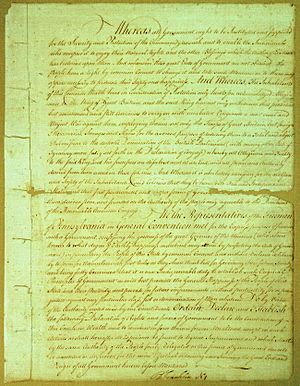Pennsylvania Constitution of 1776 facts for kids
The Pennsylvania Constitution of 1776 was Pennsylvania's first official rulebook after it declared independence from Great Britain. It was approved on September 28, 1776. Many people thought it was the most democratic, or fair, constitution in America at that time.
This important document was written by several key figures. These included Robert Whitehill, Timothy Matlack, Dr. Thomas Young, George Bryan, James Cannon, and Benjamin Franklin. Pennsylvania's new government setup was very new and democratic. It had a single-house legislature and a group of leaders instead of just one. This idea might have even influenced France's government later on. The constitution also included a list of rights for people, similar to Virginia's Declaration of Rights from the same year.
Why Pennsylvania Needed a New Constitution
Pennsylvania's new constitution came about because of big political changes in 1776. As the American Revolution grew, some leaders disagreed with the old government. This included the Provincial Assembly and the Deputy Governor, John Penn. New groups, called "extralegal committees," started forming. These groups eventually took over the government.
For example, in June 1774, Governor Penn refused to call a meeting. People wanted to discuss how to respond to the British government's actions after the Boston Tea Party. So, a large public meeting was held in Philadelphia. About 8,000 people attended, led by John Dickinson and Thomas Willing. They called for the First Continental Congress. They also set up a committee to communicate with other colonies.
Even though the old Assembly later agreed to some of these ideas, public action committees moved faster. These committees had huge public support. They even created a military group for defense. In May 1776, the Second Continental Congress suggested getting rid of royal governors. They also wanted to replace assemblies that didn't support the groups against the British Crown.
In June 1776, the Pennsylvania Provincial Conference decided the current Assembly wasn't fit to handle things. They called for a special meeting to create a new colonial government.
Creating a New Government
Before this, many powerful leaders in Pennsylvania didn't want full independence. They hoped to make peace with the British Crown. However, the Continental Congress encouraged more radical groups in Pennsylvania. These groups then gained more power.
Soon after, in June 1776, these committees called a state convention. This meeting took place on July 15, 1776. The convention completely replaced the old government. It set up a Council of Safety to rule temporarily. It also wrote the new state constitution. This constitution was officially adopted on September 28, 1776.
However, many citizens did not support this change in government. Some of these people included John Dickinson, James Wilson, Robert Morris, and Frederick Muhlenberg.
The special convention met in Philadelphia. Benjamin Franklin was chosen as its president. Colonel George Ross was the vice-president. John Morris was the secretary. From the start, this convention held the state's temporary political power. The constitution was finished on September 28. It was then signed by the president and members. It was given to the Committee of Safety. This committee was told to deliver it to the new General Assembly. The first meeting of the Pennsylvania General Assembly was on November 28, 1776. Thomas Wharton Jr., who led the Committee of Safety, became the first President of the Supreme Executive Council in June 1777. He was basically the first governor of the state.
New Ideas in the Constitution
The Pennsylvania Constitution of 1776 brought in several new and bold ideas for its time. These included:
- Voting Rights: All men who paid taxes could vote. This was new because it was less strict than requiring voters to own land.
- One-House Legislature: The government had a single legislative body, called a unicameral legislature. Members were elected for one term.
- Executive Council: A group of twelve members, called the Supreme Executive Council, managed the government.
- Judges: Judges were chosen by the legislature for seven-year terms. They could be removed at any time.
- New Laws: Any new law that was approved would only start at the next Assembly session. This gave people time to think about the law's usefulness.
- President: A President was chosen by both the Assembly and the Council. Thomas Wharton Jr. became the first President in 1777.
- Council of Censors: A special group, elected every seven years, checked on the state government. They could criticize government actions. They could also recommend that the legislature cancel laws that seemed to break the constitution. This Council was the only group that could call a meeting to change the constitution.
The constitution also gave Pennsylvania its official name: the "Commonwealth of Pennsylvania." Today, three other states (Kentucky, Massachusetts, and Virginia) also call themselves "commonwealths." This constitution also served as a model for Vermont's 1777 constitution. Vermont's constitution helped create the state, which was known as the Vermont Republic for a while. This was because both New York and New Hampshire claimed the land. Vermont officially joined the United States in 1791.


